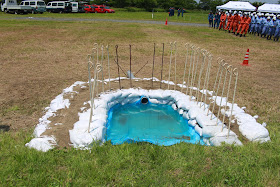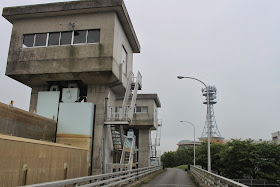Last month while mount Tsukuba reflected in the watered rice paddies, we ventured to a private
flood fighting drill at Kokai river's Asahigaoka town.
Asahigaoka was a rural area in great danger of flooding. As an example to other areas, all the residents were united in the plan to relocate the houses and industries to a concentrated elevated area, and redistribute the remaining land as low lying farm land. Two notable exceptions were a large industrial factory, and a cemetery, both still in the same location albeit on elevated land. The farm land doubles as a retarding basin, and one of the levees at the East side doubles as an overflow levee during high water. Today it was not flooded with water, but rather with firetrucks, as all the local flood fighting teams (suibo), which often double as fire fighters, came to practice their mandatory drills with much enthusiasm and military preciseness.


Much like the Tone river drill, though on a somewhat smaller scale and without helicopters saving people from rafts in the river, the individual groups reported their presences and eagerness to fight the simulated floods. The different types of simulated floods, overtopping, seepage and levee breach, as well as the methods to counteract them (many using bamboo), were much the same as during the Tone river drill. This time however, we got to stand right in the action zone and even got to lift a 20 kg sandbag. Most important was how to practice the knots tied to trees to slow down water.
We conducted interviews with several members of the flood fighting teams. As soon as the final drills were reported complete, everyone packed up and within 5 minutes the fields were clear as if there had never been anyone there. The seriousness and collaboration of the whole morning was very impressive, as many of these people are volunteers.




































